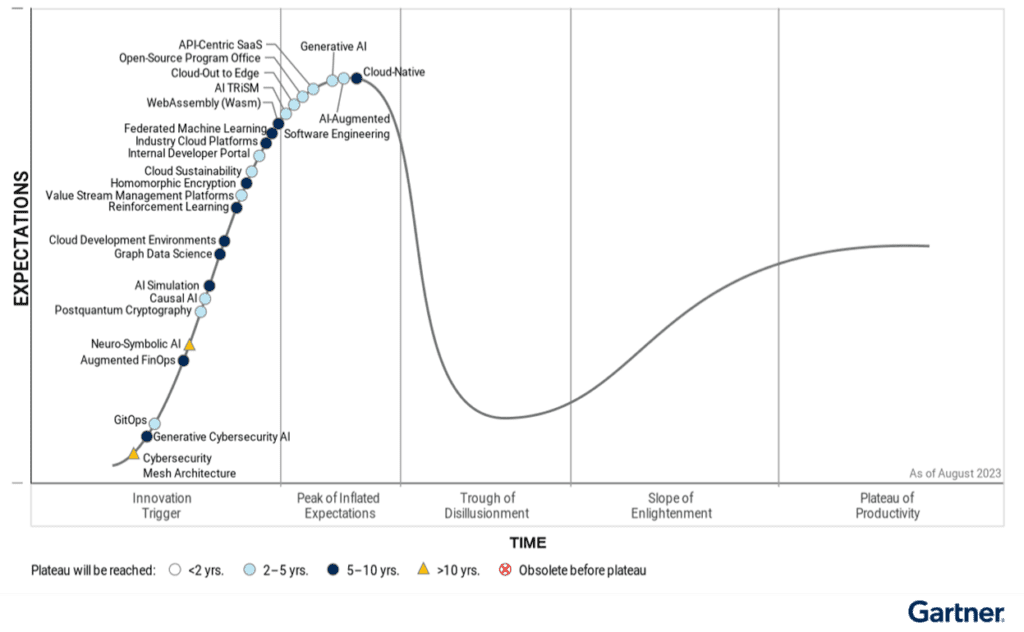Generative AI in IP

Avoiding the Trough of Disillusionment
Goldman Sachs predicts that AI will impact 44% of jobs in the legal sector. This prediction needs to sit alongside the ABA 2023 Artificial Intelligence (AI) TechReport, which reported that 10.9% of lawyers currently use AI solutions. Yet 44.3% report time-saving and efficiency gains from using AI. When considering generative AI in Intellectual Property specifically, 87% of professionals are interested in adoption and 82% expect generative AI to take over a range of repetitive administrative tasks, key findings of the LexisNexis 2024 report on How Generative AI is Shaping the Future of Work. This is a complex topic that sits at the heart of the evolution of the IP profession.
A brief history of AI in IP
ChatGPT launched on November 30, 2022, and reached 1 million users within 5 days. The hype for generative artificial intelligence (GenAI) has been unprecedented. The Gartner hype curve for AI illustrates this well. GenAI has now passed the Peak of Inflated Expectations and is heading for the Trough of Disillusionment. Is there a way to avoid this?

Figure 1: Gartner Hype Cycle for Artificial Intelligence, 2024
The starting point is context. GenAI is not the birth of AI. That dates back to Turing (1950) and arguably long before that. In the field of intellectual property, AI has been in commercial applications for over a decade. The journey of LexisNexis Intellectual Property Solutions illustrates this (Fig. 1).
This includes:
- LexisNexis Cipher Clustering (2013) and Classification (2015), using both unsupervised and supervised machine learning to map patents to technologies, building fully customized taxonomies
- LexisNexis TotalPatent One Machine Translation of patent documents (2016), essential for an effective patent system where dissemination of information is fundamental
- LexisNexisPatentSight+ Technology Clusters (2020) and Similarity Search (2021), using natural language processing
- LexisNexis IPlytics Standard Essentiality Score (2022), aimed at closing the significant gap between patents declared to be Standard Essential Patents (SEPs) and patents which are actually essential
- LexisNexis TechDiscovery, using a combination of both machine learning and GenAI to generate patent landscapes from natural language

Figure 2: LexisNexis Intellectual Property Solutions, AI journey
Perhaps the biggest change in adopting AI in IP over the last decade is not the technology at our disposal but our attitudes to adoption. Using LexisNexis Classification powered by Cipher as an example, this was launched in 2013 as a solution to the painstaking manual work required by those analyzing large patent landscapes where Boolean search processes were both slow and expensive – or simply not a credible starting point. The adoption challenge at that point was trust. Boolean is rules-based, and there is a certain lack of explainability in many AI solutions. Fast forward to 2024. Anyone launching a new product into the intellectual property market must present a compelling narrative about artificial intelligence, preferably involving GenAI. The only change is the level of hype.
A rational approach to the adoption of AI in IP solutions
IP leaders do not wake up hoping for more data or more technology. Their north star is delivering more value (or mitigating risk) to the business. Gone are the days when a patent team was recognised or rewarded on the size of the patent portfolio. Indeed, it was this historic practice that takes some of the blame for the perception of IP teams purely as a cost centre.
So the rational approach to the adoption of AI, or indeed any new technology is to start with why. The Simon Sinek approach is to be commended for IP professionals, where it is imperative to focus on the problem that needs to be solved (the why), in favour of hunting a specific technology (the how) or a specific user interface (the what).

Source: Simon Sinek
This can be illustrated by referring back to the LexisNexis solutions referenced above.
Restating the AI solutions as problems makes all the difference
- Mapping patents to technologies: this is the fundamental requirement for benchmarking, competitive intelligence and the majority of strategic patent challenges. If CPC/IPC codes had been up to the task, there would have been no need for an alternative approach, whether AI or otherwise
- Accessibility of information in foreign filings: There are over 100 patent offices and nearly as many languages. This means that no one can possibly understand what has been patented (a fundamental to the concept of global prior art) without an effective system of translation. It was not until 2004 that the European Patent Office launched its early machine translation system, and this capability quickly became table stakes for all credible providers of patent information
- Identification of SEPs: Investment in telecommunication standards underpin the fourth industrial revolution and the connected world. This requires a system for determining fair royalty payments from the users of a standard (the licensees) to the developers (licensors). Any approach to SEP analysis that reduces uncertainty around essentiality increases transactional efficiency
- Understanding who owns what: In a world of over 50m active patents and over 5,000 new applications a day, there needs to be a way of finding out who owns what. This is not just a problem for IP professionals but for those working in R&D, on mergers & acquisitions, IP insurance and many others. Many of the teams requiring this information have little to no understanding of the patent system but do want access to the information trapped within. Systems that are easy to use and respond with actional insights are, therefore, important
Avoiding the Trough of Disillusionment
The trough of disillusionment measures the gap between expectations and reality. In June 2023, a New York judge sanctioned a lawyer for submitting a GenAI brief that cited non-existent cases. What went wrong (apart from everything)? This is a clear case of choosing the wrong tool for the job, a lack of education and controls and an absence of transparency.
The following is a non-exhaustive list of ideas for avoiding disappointment when adopting AI into your operations:
- Focus on your high-priority problems – that will narrow down your choice to things that might credibly help. AI for automated patent drafting might be exciting, but not if you outsource your patent drafting and filing
- Understand today and tomorrow – AI is a fast-moving technology. Engage now so that you understand the trends and can distinguish between approaches that are for now and others that may be important later. Organizations like LexisNexis share the details of their future roadmap with their clients to ensure that investments are directed toward the right areas.
- What does good look like? Avoid the trap of setting measures of accuracy that are not achievable by any existing alternative. The guiding light is one or more of better, faster, cheaper. There is no such thing as a perfect instant zero-cost solution
What we know and have known for centuries is that technology has and will impact our working lives – and for the better. The impact of change is a little scary but no more radical than electricity or the internet. While it seems inevitable that IP law and practice will change, there are rewards for those who engage and extinction risks for those who are left behind. Enjoy the ride.

About Nigel
Nigel Swycher is co-founder and CEO of LexisNexis Cipher – His background is in law, where he led the IP practice at leading law firm Slaughter and May.
Nigel has been recognized for many years by the IAM 300 as a leader in the field of IP strategy.
Join the AI-Insider program to shape the future of AI in IP Solutions
Members of the PatentSight+ AI-Insider program will lead the advancement of artificial intelligence in intellectual property and help revolutionize the way high-value strategic insights can be gained from
AI-powered IP search and analytics.

- Exclusive Access: Get early access to information on our latest AI products.
- Early insights: Shape the future of AI solutions by feedback in focus groups.
- Be on the Inside Track: Gain privileged access to resources, events, and updates.
